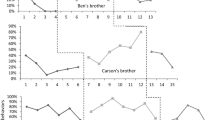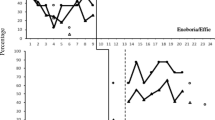Abstract
This research examined mothers’ and sisters’ perceptions of sibling relationships in families with a brother with autism spectrum disorder (ASD) in the context of a strengths-based, family-focused 3D technology program designed for youth on the spectrum. Seven sisters and six mothers participated in semi-structured interviews, which were coded for emergent themes. Both similarities and differences between sisters’ and mothers’ perceptions of the sibling relationship emerged from the narratives. Sisters and mothers framed the sibling relationship differently within the context of everyday life activities compared to the context of their brother’s involvement in the technology program that highlighted his skills and abilities. Within the context of everyday life, sisters described the dual nature of their relationships, involving both positive and negative qualities, whereas mothers focused on the challenges in the sibling relationship. Both mothers and sisters identified the “sister” role in the sibling relationship as that of a nurturer. Within the context of the technology program, mothers and sisters both perceived the boys’ roles as shifting positively relative to the context of everyday life. Sisters spoke of a sense of pride in their brother’s accomplishments in 3D design, whereas mothers spoke about their children being more engaged with one another because of their shared interests in the program. We discuss implications for interventions with families with a child with ASD.

Similar content being viewed by others
References
American Psychiatric Association. (2013). Diagnostic and statistical manual of mental disorders (5th ed.). Arlington, VA: American Psychiatric Publishing.
Angell, M. E., Meadan, H., & Stoner, J. B. (2012). Experiences of siblings of individuals with autism spectrum disorders. Autism Research and Treatment, 2012, 1–11.
Arnold, C. K., Heller, T., & Kramer, J. (2012). Support needs of siblings of people with developmental disabilities. Intellectual and Developmental Disabilities, 50, 373–382.
Bagenholm, A., & Gillberg, C. (1991). Psychosocial effects on siblings of children with autism and mental retardation: A population based study. Journal of Mental Deficiency Research, 35, 291–307.
Baumann, S., Dyches, T., & Braddick, M. (2005). Being a sibling. Nursing Science Quarterly, 18, 51–58.
Benderix, Y., & Sivberg, S. (2007). Siblings’ experiences of having a brother or sister with autism and mental retardation. A case study of 14 siblings from 5 families. International Pediatric Nursing, 22(5), 410–418.
Benson, P. R. (2010). Coping, distress, and well-being in mothers of children with autism. Research in Autism Spectrum Disorders, 4, 217–228. doi:10.1016/j.rasd.2009.09.008.
Beyer, J. F. (2009). Autism spectrum disorders and sibling relationships: Research and strategies. Education Training in Developmental Disabilities, 44(4), 444–452.
Bogdan, R. C., & Biklen, S. K. (2007). Qualitative research for education: An introduction to theories and methods (5th ed.). Boston, MA: Pearson Education Inc.
Brantlinger, E., Jimenez, R., Klingner, J., Pugach, M., & Richardson, V. (2005). Qualitative studies in special education. Exceptional Children, 71, 195–207.
Brody, J. (2004). Siblings’ direct and indirect contributions to child development. Current Directions in Psychological Science, 13, 124–126. doi:10.1111/j.0963-7214.2004.00289.
Centers for Disease Control and Prevention. (2012). Prevalence of autism spectrum disorders: Autism and developmental disabilities monitoring network, United States, 2008. Report for Morbidity and Mortal Weekly, 61(3), 1–19.
Cicirelli, V. G. (1995). Sibling relationships across the lifespan. New York: Plenum Publishers.
Dempsey, A. G., Llorens, A., Brewton, C., Mulchandani, S., & Goin-Kochel, R. P. (2012). Emotional and behavioral adjustment in typically developing siblings of children with autism spectrum disorders. Journal of Autism and Developmental Disorders, 42, 1393–1402.
Feinberg, M., Solmeyer, A. R., & McHale, v. (2012). The third rail of family systems: Sibling relationships, mental and behavioral health, and preventive intervention in childhood and adolescence. Clinical Child and Family Psychology Review, 15(1), 43–57.
Ferraioli, S. J., & Harris, S. L. (2010). The impact of autism on siblings. Social Work in Mental Health, 8, 41–53.
Gardiner, E., & Iarocci, G. (2012). Unhappy (and happy) in their own way: A developmental psychopathology perspective on quality of life for families living with developmental disability with and without autism. Research in Developmental Disabilities, 33, 2177–2192. doi:10.1016/j.ridd.2012.06.014.
Grandin, T. (1995). Thinking in pictures. London: Doubleday.
Hastings, R. P. (2003). Behavioral adjustment of siblings of children with autism engaged in applied behavior analysis early intervention programs: The moderating role of social support. Journal of Autism and Developmental Disorders, 33(2), 141–150.
Hodapp, R. M., & Urbano, R. C. (2007). Adult siblings of individuals with Down syndrome versus with autism: Findings from a large-scale US survey. Journal of Intellectual Disability Research, 51, 1018–1029.
Hodapp, R. M., Urbano, R. C., & Burke, M. M. (2010). Adult female and male siblings of persons with disabilities: Findings from a national survey. Intellectual and Developmental Disabilities, 48, 52–62.
Howe, N., Karos, L. K., & Aquan-Assee, J. (2011). Sibling relationship quality in early adolescence: Child and maternal perceptions and daily interactions. Infant and Child Development, 20, 227–245.
Interagency Autism Coordinating Committee, US Department of Health and Human Services. (2011). The interagency autism coordinating committee strategic plan for autism spectrum disorder research, January 18, 2011. Retrieved from http://iacc.hhs.gov/strategic-plan/2011/future.html (Accessed April 13, 2010).
Kaminsky, L., & Dewey, D. (2001). Sibling relationships of children with autism. Journal of Autism and Developmental Disorders, 31, 399–410.
Kennedy, D. M., & Banks, R. S. (2011). Bright not broken: Gifted kids, ADHD, and autism. New York: Wiley.
Kim, J. Y., McHale, S. M., Osgood, D. W., & Crouter, A. C. (2006). Longitudinal course and family correlates of sibling relationships from childhood through adolescence. Child Development, 77(6), 1746–1761.
Knight, V. F., McKissick, B. R., & Saunders, A. (2013). A review of technology-based interventions to teach academic skills to students with autism spectrum disorder. Journal of Autism and Developmental Disorders,. doi:10.1007/s10803-013-1814-y.
Knott, F., Lewis, C., & Williams, T. (1995). Sibling interactions of children with learning disabilities: A comparison of autism and Down’s syndrome. Journal of Child Psychology and Psychiatry, 56, 965–976.
Kowal, A., & Kramer, L. (1997). Children’s understanding of parental differential treatment. Child Development, 68, 113–126.
Kramer, L. (2010). The essential ingredients of successful sibling relationships: An emerging framework for advancing theory and practice. Child Development Perspectives, 4(2), 80–86.
Kramer, L., & Baron, L. A. (1995). Parental perceptions of children’s sibling relationships. Family Relations, 44(1), 95–103.
Macks, R. J., & Reeve, R. E. (2007). The adjustment of non-disabled siblings of children. Journal of Autism and Developmental Disorders, 37, 1060–1106.
Mascha, K., & Boucher, J. (2006). Preliminary investigation of a qualitative method of examining siblings’ experiences of living with a child with ASD. Journal of Intellectual and Developmental Disabilities, 52, 19–28.
Matson, J. L., & Kozlowski, A. M. (2011). The increasing prevalence of autism spectrum disorders. Research in Autism Spectrum Disorders, 5, 418–425. doi:10.1016/j.rasd.2010.06.004.
McHale, S. M., & Crouter, A. C. (1996). The family contexts of children’s sibling relationships. Advances in Applied Developmental Psychology, 10, 173–195.
McHale, S. M., & Pawletko, T. M. (1992). Differential treatment of siblings in two family contexts. Child Development, 63(1), 68–81.
Meadan, H., Stoner, J. B., & Angell, M. E. (2010). Review of the Literature Related to the Social, Emotional, and Behavioral Adjustment of Siblings of Individuals with Autism Spectrum Disorder. Journal of Developmental and Physical Disabilities, 22, 83–100.
Meirsschaut, M., Roeyers, H., & Warreyn, P. (2010). Parenting in families with a child with autism spectrum disorder and a typically developing child: Mother’s experiences and cognitions. Research in Autism Spectrum Disorders, 4, 661–669.
Meyer, K. A., Ingersoll, B., & Hambrick, D. Z. (2011). Factors influencing adjustment in siblings of children with autism spectrum disorders. Research in Autism Spectrum Disorders, 5, 1413–1420. doi:10.1016/j.rasd.2011.01.027.
Minkler, M., & Wallerstein, N. (Eds.). (2008). Community based participatory research for health. San Francisco: Jossey-Bass.
Nealy, C. E., O’Hare, L., Powers, J. D., & Swick, D. (2012). The impact of Autism Spectrum Disorders on the family: A qualitative study of mothers’ perspectives. Journal of Family Social Work, 15, 187–201.
Nielsen, K. M., Mandleco, B., Roper, S. O., Cox, A., Dyches, T., & Marshall, E. S. (2012). Parental perceptions of sibling relationships in families rearing a child with a chronic condition. Journal of Pediatric Nursing, 27, 34–43. doi:10.1016/j.pedn.2010.08.009.
Oppenheim-Leaf, M. L., Leaf, J. B., Dozier, C., Sheldon, J. B., & Sherman, J. A. (2012). Teaching typically developing children to promote social play with their siblings with autism. Research in Autism Spectrum Disorders, 6, 777–791.
Orsmond, G., Kuo, H., & Seltzer, M. (2009). Siblings of individuals with an autism spectrum disorder: Sibling relationships and wellbeing in adolescence and adulthood. Autism, 13(1), 59–80.
Orsmond, G., & Seltzer, M. M. (2000). Brothers and sisters of adults with mental retardation: Gendered nature of the sibling relationship. American Journal of Mental Retardation, 105, 486–508.
Orsmond, G., & Seltzer, M. (2007). Siblings of individuals with autism or Down syndrome: Effect on adult lives. Journal of Intellectual Disability Research, 51, 682–696.
Petalas, M. A., Hastings, R. P., Nash, S., Downey, A., & Reilly, D. (2009). “I like that he always shows who he is”: The perceptions and experiences of siblings with a brother with autism spectrum disorder. Autism, 13(4), 471–483.
Pope, C., Ziebland, S., & Mays, N. (2000). Qualitative research in health care. Analysing qualitative data. British Medical Journal, 320, 114–116.
Rivers, J. W., & Stoneman, Z. (2003). Sibling relationships when a child has autism: Marital stress and support coping. Journal of Autism and Developmental Disorders, 33(4), 383–394.
Rivers, J. W., & Stoneman, Z. (2008). Child temperaments, differential parenting, and the sibling relationships of children with autism spectrum disorders. Journal of Autism and Developmental Disorders, 38, 1740–1750.
Ross, P., & Cuskelly, M. (2006). Adjustment sibling problems and coping strategies of brothers and sisters of children with autistic spectrum disorders. Journal of Intellectual & Developmental Disability, 31, 77–86.
Stoneman, Z. (2001). Supporting positive sibling relationships during childhood. Mental Retardation and Developmental Disabilities Research Reviews, 7, 134–142.
Tomeny, T. S., Barry, T. D., & Bader, S. H. (2012). Are typically developing siblings of children with autism spectrum disorder at risk for behavioral, emotional, and social maladjustment? Research in Autism Spectrum Disorders, 6, 508–518.
Tsao, L. L., Davenport, R., & Schmiege, C. (2011). Supporting siblings of children with autism spectrum disorders. Early Childhood Education Journal,. doi:10.1007/s10643-011-0488-3.
Turnbull, A., Turnbull, H. R., Erwin, E. J., Soodak, L. C., & Shogren, K. A. (2011). Families, professionals, and exceptionality: Positive outcomes through partnerships and trust (6th ed.). Columbus, OH: Merrill.
Verte, S., Roeyers, H., & Buysse, A. (2003). Behavioral problems, social competence and self-concept in siblings of children with autism. Child: Care, Health & Development, 29, 193–205.
Wallerstein, N. B., & Duran, B. (2006). Using community-based participatory research to address health disparities. Health Promotion Practice, 7, 312–323. doi:10.1177/1524839906289376.
Willig, C. (2008). Introducing qualitative research in psychology. New York: Open University Press.
Wright, C., Diener, M. L., Dunn, L., & Wright, S. D. (2011). SketchUp™: A technology tool to facilitate intergenerational family relationships for children with autism spectrum disorders (ASD). Family and Consumer Studies Research Journal, 40, 135–149.
Author information
Authors and Affiliations
Corresponding author
Appendix
Appendix
Interview Questions for Siblings
-
Tell me about a typical day in your house with your brother.
-
Tell me about your relationship with your brother.
-
What is your favorite thing to do with your brother?
-
What is challenging with your brother?
-
What do you know about SketchUp?
-
What have you seen your brother do with SketchUp?
Interview Questions for Mothers
-
Tell me about the relationship between your children.
-
What are some things that your children enjoy doing together?
-
What are some things that are difficult for your children to do together?
-
What was your experience with the SketchUp workshops?
-
Did your other child (sibling) have a role in the workshops? If so, what was it? If not, why not?
-
What did your child (sibling) enjoy about the workshops?
-
What were the challenges for your child (sibling) with the workshops?
Rights and permissions
About this article
Cite this article
Diener, M.L., Anderson, L., Wright, C.A. et al. Sibling Relationships of Children with Autism Spectrum Disorder in the Context of Everyday Life and a Strength-Based Program. J Child Fam Stud 24, 1060–1072 (2015). https://doi.org/10.1007/s10826-014-9915-6
Published:
Issue Date:
DOI: https://doi.org/10.1007/s10826-014-9915-6




